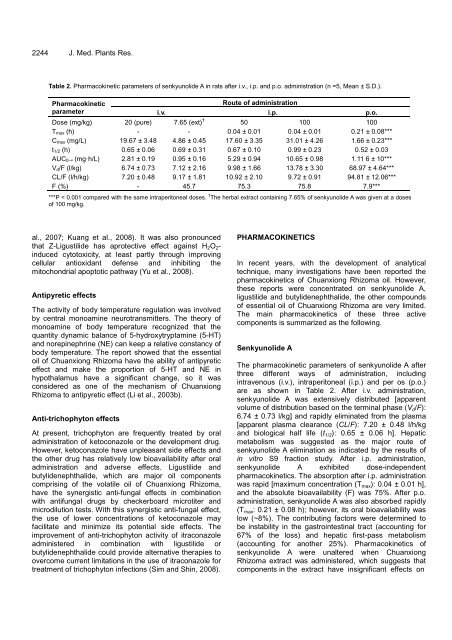Download Complete Issue - Academic Journals
Download Complete Issue - Academic Journals
Download Complete Issue - Academic Journals
You also want an ePaper? Increase the reach of your titles
YUMPU automatically turns print PDFs into web optimized ePapers that Google loves.
2244 J. Med. Plants Res.<br />
Table 2. Pharmacokinetic parameters of senkyunolide A in rats after i.v., i.p. and p.o. administration (n =5, Mean ± S.D.).<br />
Pharmacokinetic<br />
parameter<br />
Route of administration<br />
i.v. i.p. p.o.<br />
Dose (mg/kg) 20 (pure) 7.65 (ext) † 50 100 100<br />
Tmax (h) - - 0.04 ± 0.01 0.04 ± 0.01 0.21 ± 0.08***<br />
Cmax (mg/L) 19.67 ± 3.48 4.86 ± 0.45 17.60 ± 3.35 31.01 ± 4.26 1.66 ± 0.23***<br />
t1/2 (h) 0.65 ± 0.06 0.69 ± 0.31 0.67 ± 0.10 0.99 ± 0.23 0.52 ± 0.03<br />
AUC0-∞ (mg·h/L) 2.81 ± 0.19 0.95 ± 0.16 5.29 ± 0.94 10.65 ± 0.98 1.11 6 ± 10***<br />
Vd/F (l/kg) 6.74 ± 0.73 7.12 ± 2.16 9.98 ± 1.66 13.78 ± 3.30 68.97 ± 4.64***<br />
CL/F (l/h/kg) 7.20 ± 0.48 9.17 ± 1.81 10.92 ± 2.10 9.72 ± 0.91 94.81 ± 12.06***<br />
F (%) - 45.7 75.3 75.8 7.9***<br />
***P < 0.001 compared with the same intraperitoneal doses. † The herbal extract containing 7.65% of senkyunolide A was given at a doses<br />
of 100 mg/kg.<br />
al., 2007; Kuang et al., 2008). It was also pronounced<br />
that Z-Ligustilide has aprotective effect against H2O2induced<br />
cytotoxicity, at least partly through improving<br />
cellular antioxidant defense and inhibiting the<br />
mitochondrial apoptotic pathway (Yu et al., 2008).<br />
Antipyretic effects<br />
The activity of body temperature regulation was involved<br />
by central monoamine neurotransmitters. The theory of<br />
monoamine of body temperature recognized that the<br />
quantity dynamic balance of 5-hydroxytryptamine (5-HT)<br />
and norepinephrine (NE) can keep a relative constancy of<br />
body temperature. The report showed that the essential<br />
oil of Chuanxiong Rhizoma have the ability of antipyretic<br />
effect and make the proportion of 5-HT and NE in<br />
hypothalamus have a significant change, so it was<br />
considered as one of the mechanism of Chuanxiong<br />
Rhizoma to antipyretic effect (Li et al., 2003b).<br />
Anti-trichophyton effects<br />
At present, trichophyton are frequently treated by oral<br />
administration of ketoconazole or the development drug.<br />
However, ketoconazole have unpleasant side effects and<br />
the other drug has relatively low bioavailability after oral<br />
administration and adverse effects. Ligustilide and<br />
butylidenephthalide, which are major oil components<br />
comprising of the volatile oil of Chuanxiong Rhizoma,<br />
have the synergistic anti-fungal effects in combination<br />
with antifungal drugs by checkerboard microtiter and<br />
microdilution tests. With this synergistic anti-fungal effect,<br />
the use of lower concentrations of ketoconazole may<br />
facilitate and minimize its potential side effects. The<br />
improvement of anti-trichophyton activity of itraconazole<br />
administered in combination with ligustilide or<br />
butylidenephthalide could provide alternative therapies to<br />
overcome current limitations in the use of itraconazole for<br />
treatment of trichophyton infections (Sim and Shin, 2008).<br />
PHARMACOKINETICS<br />
In recent years, with the development of analytical<br />
technique, many investigations have been reported the<br />
pharmacokinetics of Chuanxiong Rhizoma oil. However,<br />
these reports were concentrated on senkyunolide A,<br />
ligustilide and butylidenephthalide, the other compounds<br />
of essential oil of Chuanxiong Rhizoma are very limited.<br />
The main pharmacokinetics of these three active<br />
components is summarized as the following.<br />
Senkyunolide A<br />
The pharmacokinetic parameters of senkyunolide A after<br />
three different ways of administration, including<br />
intravenous (i.v.), intraperitoneal (i.p.) and per os (p.o.)<br />
are as shown in Table 2. After i.v. administration,<br />
senkyunolide A was extensively distributed [apparent<br />
volume of distribution based on the terminal phase (Vd/F):<br />
6.74 ± 0.73 l/kg] and rapidly eliminated from the plasma<br />
[apparent plasma clearance (CL/F): 7.20 ± 0.48 l/h/kg<br />
and biological half life (t1/2): 0.65 ± 0.06 h]. Hepatic<br />
metabolism was suggested as the major route of<br />
senkyunolide A elimination as indicated by the results of<br />
in vitro S9 fraction study. After i.p. administration,<br />
senkyunolide A exhibited dose-independent<br />
pharmacokinetics. The absorption after i.p. administration<br />
was rapid [maximum concentration (Tmax): 0.04 ± 0.01 h],<br />
and the absolute bioavailability (F) was 75%. After p.o.<br />
administration, senkyunolide A was also absorbed rapidly<br />
(Tmax: 0.21 ± 0.08 h); however, its oral bioavailability was<br />
low (~8%). The contributing factors were determined to<br />
be instability in the gastrointestinal tract (accounting for<br />
67% of the loss) and hepatic first-pass metabolism<br />
(accounting for another 25%). Pharmacokinetics of<br />
senkyunolide A were unaltered when Chuanxiong<br />
Rhizoma extract was administered, which suggests that<br />
components in the extract have insignificant effects on

















